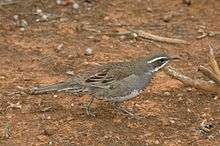Cinclosomatidae
Cinclosomatidae is a family of passerine birds native to Australia and New Guinea. It has a complicated taxonomic history and different authors vary in which birds they include in the family. It includes the quail-thrushes and jewel-babblers.
| Cinclosomatidae | |
|---|---|
.jpg) | |
| Spotted quail-thrush (Cinclosoma punctatum) | |
| Scientific classification | |
| Kingdom: | Animalia |
| Phylum: | Chordata |
| Class: | Aves |
| Order: | Passeriformes |
| Superfamily: | Corvoidea |
| Family: | Cinclosomatidae Mathews, 1921 |
| Genera | |
|
See list below | |
Taxonomy
The quail-thrushes, jewel-babblers, whipbirds and wedgebills were traditionally included with the logrunners (Orthonyx) in the family Orthonychidae.[1] Sometimes the Malaysian rail-babbler and blue-capped ifrit (Ifrita kowaldi) were also included in the family.[2] In 1985, Sibley and Ahlquist found that the logrunners were not related to the others and included only the logrunners in the Orthonychidae.[3] They treated the others as the subfamily Cinclosomatinae within their expanded family Corvidae.[4]
A number of authors later treated the quail-thrushes and allies as the family Cinclosomatidae, a name first coined by Gregory Mathews in 1921–1922. However, if the whipbirds are included in the family, the older name Psophodidae Bonaparte, 1854 has priority. If the Malaysian rail-babbler is also included, the name Eupetidae Bonaparte, 1850 has priority.[3]
The Malaysian rail-babbler has now been shown to be unrelated to the others, probably being an early offshoot of the Passerida.[5] Another study found the quail-thrushes and jewel-babblers to be related to each other but did not show them to have a close relationship with Psophodes or Ifrita.[6]
Description
The quail-thrushes and jewel babblers are medium-sized songbirds, 17–28 cm in length.[7][8] They have strong legs and bills. Males and females often differ in plumage markings. The quail-thrushes are largely brown above, the colour varying to provide camouflage against the soil, but are more boldly marked with black and white below.[8] Jewel-babblers usually have extensive blue in their plumage.[7] Most species have loud, distinctive songs.[9]
Distribution and habitat
Jewel-babblers are found on New Guinea and the neighbouring islands of Yapen, Batanta, Misool and Salawati.[7] They occur in forest, generally replacing each other at different altitudes. The painted quail-thrush is also found in the forests of New Guinea.[7] The other quail-thrushes are restricted to Australia where they are found in drier habitats, occurring in open forest, scrub and on stony ground.[8] None of the species are thought to be threatened but one subspecies of the spotted quail-thrush is certainly critically endangered and possibly extinct.[10]
Behaviour

Jewel-babblers and Quail-thrushes are terrestrial birds which fly fairly weakly and prefer to squat or run when disturbed.[1] They forage on the ground feeding mainly on insects and other invertebrates.[9] In the desert, quail-thrushes also eat some seeds.[1]
They build a cup-shaped nest among shrubs or on the ground. Two or three eggs are laid.[9]
Species list
- Genus Cinclosoma – quail-thrushes
- Painted quail-thrush, Cinclosoma ajax
- Spotted quail-thrush, Cinclosoma punctatum
- Chestnut quail-thrush, Cinclosoma castanotum
- Copperback quail-thrush, Cinclosoma clarum
- Chestnut-breasted quail-thrush, Cinclosoma castaneothorax
- Western quail-thrush, Cinclosoma marginatum
- Nullarbor quail-thrush, Cinclosoma alisteri
- Cinnamon quail-thrush, Cinclosoma cinnamomeum
- Genus Ptilorrhoa – jewel-babblers
- Spotted jewel-babbler, Ptilorrhoa leucosticta
- Blue jewel-babbler, Ptilorrhoa caerulescens
- Brown-headed jewel-babbler, Ptilorrhoa (caerulescens) geisleroroum
- Chestnut-backed jewel-babbler, Ptilorrhoa castanonota
References
- Roberson, Don (2004) Quail-thrushes Cinclosomatidae, Bird Families of the World. Accessed 4 January 2010.
- Howard, Richard & Alick Moore (1980) A complete checklist of the Birds of the World, 1st ed., Oxford University Press, Oxford.
- Christidis, Les & Walter Boles (2008) Systematics and Taxonomy of Australian Birds, CSIRO Publishing.
- Sibley's Sequence: Passeriformes. Accessed 4 January 2010.
- Jønsson, K.A., J. Fjeldså, P.G.P. Ericson, and M. Irestedt (2007) Systematic placement of an enigmatic Southeast Asian taxon Eupetes macrocerus and implications for the biogeography of a main songbird radiation, the Passerida, Biology Letters 3(3):323–326.
- Norman, Janette A., Per G.P. Ericson, Knud A. Jønsson, Jon Fjeldså & Les Christidis (2009) A multi-gene phylogeny reveals novel relationships for aberrant genera of Australo-Papuan core Corvoidea and polyphyly of the Pachycephalidae and Psophodidae (Aves: Passeriformes), Molecular Phylogenetics and Evolution, 52:488–497.
- Coates, Brian J. & William S. Peckover (2001), Birds of New Guinea and the Bismarck Archipelago: a photographic guide, Dove Publications, Alderley, Australia.
- Pizzey, Graham & Frank Knight (1997) Field Guide to the Birds of Australia, HarperCollins, London, UK.
- Perrins, Christopher, ed. (2004) The New Encyclopedia of Birds, Oxford University Press, Oxford.
- "Cinclosoma punctatum anachoreta Spotted Quail-thrush". Australian Government: Department of the Environment and Energy. Retrieved 9 July 2019.